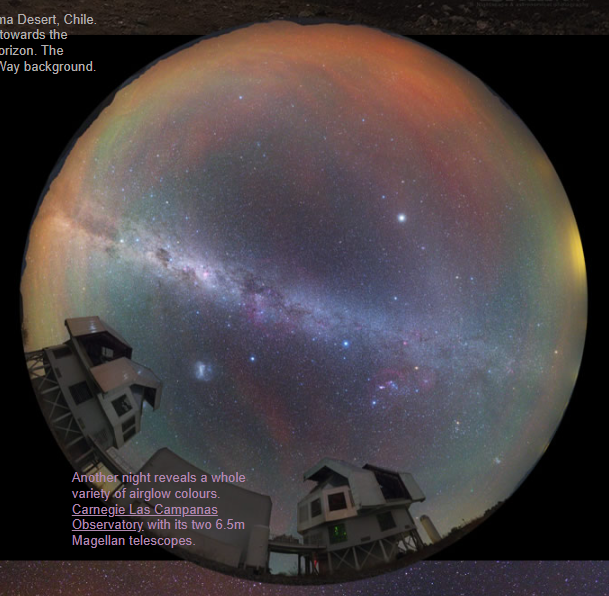Airglow, Atacama Desert, Chile - Yuri Beletsky - OPOD
Airglow: Illuminating the Night Sky in the Atacama Desert, Chile
When the sun sets and darkness falls, the night sky is never completely devoid of light. Even in the absence of artificial lights, moonlight, or aurorae, a soft glow permeates the atmosphere. This phenomenon is known as airglow, and it can be observed in the clear dark skies of the Atacama Desert in Chile, as beautifully captured by photographer Yuri Beletsky.
The Enigmatic Glow
To witness the ethereal airglow, one must venture to a location with minimal light pollution and allow their eyes to adapt to the darkness. Only then can they experience the awe-inspiring sight of a luminous sky, where stars twinkle with intensity and the Milky Way sprawls across the heavens like a radiant tapestry. In this celestial panorama, the sky itself emanates a gentle luminescence, rendering any object held against it a striking silhouette.
Unlike the localized phenomenon of aurorae, which are confined to polar regions, airglow can be observed worldwide. Although it possesses distinct colors, such as green and red, these hues elude our unaided eyes due to their subtle intensity falling below our threshold of color perception. When viewed from space, airglow envelops the Earth like a green bubble.
Unveiling the Science Behind Airglow
The mesmerizing phenomenon of airglow arises from the excitation of the upper atmosphere by solar ultraviolet radiation. As opposed to aurorae, which are triggered by particles descending from Earth's magnetosphere, airglow predominantly consists of narrow-frequency emissions resulting from transitions within excited oxygen atoms (green and red) and OH radicals (deeper red).
In some instances, airglow manifests as distinct bands across the sky. These bands owe their existence to gravity waves that propagate upwards from the atmosphere below, modulating the conditions of the tenuous gas and influencing the emission of light. As these waves traverse the atmosphere, they give rise to bands that can appear to traverse the sky and converge towards two opposite points on the horizon, akin to the mesmerizing crepuscular and anticrepuscular rays. This apparent convergence is an optical illusion resulting from the parallel alignment of the glowing bands and the perspective effects they create.
Airglow in the Company of Galaxies
In the captivating images captured by Yuri Beletsky, airglow shares the stage with our celestial companions, the Magellanic Clouds. While airglow dominates the sky area, it pales in comparison when it comes to brightness. The faintness of airglow emissions becomes evident when juxtaposed against the radiant splendor of these neighboring galaxies.
Airglow remains a subject of fascination for scientists and sky gazers alike. Its intricate interplay with atmospheric conditions and solar radiation continues to be a topic of study, enabling us to unravel the mysteries of our planet's luminous nightscape.
Note: This article has been automatically converted from the old site and may not appear as intended.

Airglow Bands ~ Images by Yuri Beletsky (FB) in the clear dark sky of the Atacama Desert, Chile. At top, red airglow covers the sky with dark bands appearing by perspective to converge towards the truncated mound holding the ESO Paranal Observatory. Green airglow shows near the horizon. The relative faintness of the atmospheric emission is revealed by the brightness of the Milky Way background. All images ©Yuri Beletsky, shown with permission
Earth’s night side sky is never completely dark. Long after sunset and even with no interference from artificial lights, moonlight or aurorae the sky has a soft glow.
To see it needs a dark sky location and long dark adaptation. Eventually, when stars are almost blinding and the Milky Way is a bright convolved mass, the sky itself will be seen to be luminous and a hand held towards the heavens will be a black silhouette.
Unlike the aurora, the airglow is visible all over the globe. It is strongly coloured but it is without colour to our unaided eyes because its light is below their threshold of colour perception. From orbit it is a green bubble enclosing the planet.

Airglow is the result of excitation of the upper atmosphere by solar ultra-violet radiation. In contrast, the more localised aurorae are excitation by particles plunging down from Earth's magnetosphere. The airglow radiation is mostly very narrow frequencies from transitions within excited oxygen atoms (green and red) and OH radicals (deeper red).
As here, the airglow is sometimes banded. Slowly moving gravity waves propagating up from the atmosphere below modulate the conditions of the tenuous gas and thus the light emission.
The bands can appear to cross the sky and converge towards two opposite points on the horizon in the same way that crepuscular and anticrepuscular rays do. The reason is the same, the glowing bands are parallel and perspective effects makes them appear to converge.

Airglow competes here with our companion galaxies, the Magellanic Clouds. It succeeds in sky area but loses badly in brightness.
Note: this article has been automatically converted from the old site and may not appear as intended. You can find the original article here.
Reference Atmospheric Optics
If you use any of the definitions, information, or data presented on Atmospheric Optics, please copy the link or reference below to properly credit us as the reference source. Thank you!
-
<a href="https://atoptics.co.uk/blog/airglow-atacama-desert-chile-yuri-beletsky-opod/">Airglow, Atacama Desert, Chile - Yuri Beletsky - OPOD</a>
-
"Airglow, Atacama Desert, Chile - Yuri Beletsky - OPOD". Atmospheric Optics. Accessed on November 26, 2024. https://atoptics.co.uk/blog/airglow-atacama-desert-chile-yuri-beletsky-opod/.
-
"Airglow, Atacama Desert, Chile - Yuri Beletsky - OPOD". Atmospheric Optics, https://atoptics.co.uk/blog/airglow-atacama-desert-chile-yuri-beletsky-opod/. Accessed 26 November, 2024
-
Airglow, Atacama Desert, Chile - Yuri Beletsky - OPOD. Atmospheric Optics. Retrieved from https://atoptics.co.uk/blog/airglow-atacama-desert-chile-yuri-beletsky-opod/.